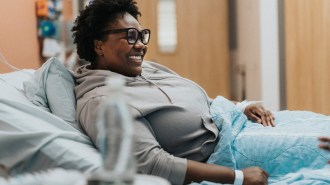Milk seems to guard against breast cancer
Milk isn’t just a boon to a woman’s bones. A new study finds that it might also protect her breasts. Norwegian scientists have linked high milk consumption to low incidence of breast cancer.
A decade ago, researchers launched the still ongoing Norwegian Women and Cancer (NOWAC) study. They recruited 100,000 participants, all 35 or older, from throughout the nation. Though the thrust of the study was to evaluate factors that affect hormones and cancer, the researchers also initially administered a rudimentary dietary survey to some 53,000 women. It surveyed current eating habits and recorded estimates of childhood milk and vegetable intake.
In 1995, Anette Hjartker, a nutritional epidemiologist at the University of Oslo, decided to consider milk consumption among the NOWAC participants.
Another Norwegian study that year had reported that drinking five or more glasses of milk per day appeared to increase a woman’s risk of breast cancer. Confusing the issue, a few other studies around that time showed hints of an anticancer role for milk.
Hjartker recognized that the NOWAC data might be able to resolve the issue. They represent a big population where milk drinking is common. Half of the study’s women downed at least a glass of milk per day; fully 10 percent consumed at least three times that much. In contrast, U.S. women average just a half-glass per day. However, most volunteers for whom dietary data were available were still premenopausal, below the age when breast cancer incidence escalates, so any effect would have to be large to show up. “I didn’t really expect to find any effect of milk,” Hjartker says.
In their analysis, Hjartker and her colleagues focused on the almost 50,000 premenopausal women. Through 1997, 317 of the women developed breast cancer. Those who drank at least three glasses of milk per day in adulthood “had a 44 percent lower incidence rate of breast cancer than women not drinking milk at all,” Hjartker’s group reports.
When the researchers factored in women’s childhood consumption, milk’s apparent benefit increased slightly. Cancer incidence in the women who reported downing three or more glasses daily throughout life was about half that in the participants who had always shunned milk.
These associations held even after adjusting for other major factors influencing cancer risk, such as current age, age at first pregnancy, and total number of pregnancies, the team notes in the Sept. 15 International Journal of Cancer. Moreover, whole, reduced-fat, and skim milk appeared equally beneficial.
Robert P. Heaney of Creighton University in Omaha, Neb., isn’t surprised by the new report. He observes that “there is a modest body of literature supporting this trend.” Some studies even suggest components that might underlie milk’s benefits, he notes, such as conjugated linoleic acid (SN: 3/3/01, p. 136: The Good Trans Fat). This fat, present in most dairy products, nearly halved the risk of mammary cancer in one rodent study (SN: 12/11/99, p. 375).
In a 1999 review, Martin Lipkin of the Rockefeller University in New York and Harold L. Newmark of Rutgers University in Piscataway, N.J., made a pitch for two additional milk constituents. The researchers cited a host of studies, including many of their own, showing anticancer benefits from vitamin D and calcium. For instance, data show that animals eating chow as high in fat as the typical U.S. diet often exhibit high rates of mammary cancer–unless the chow is fortified with extra vitamin D and calcium.
Lipkin and Newmark also noted that breast cancer incidence and mortality tend to be high where sunlight exposures–necessary for the body to make vitamin D–are low, such as in northeastern U.S. states with polluted skies.







